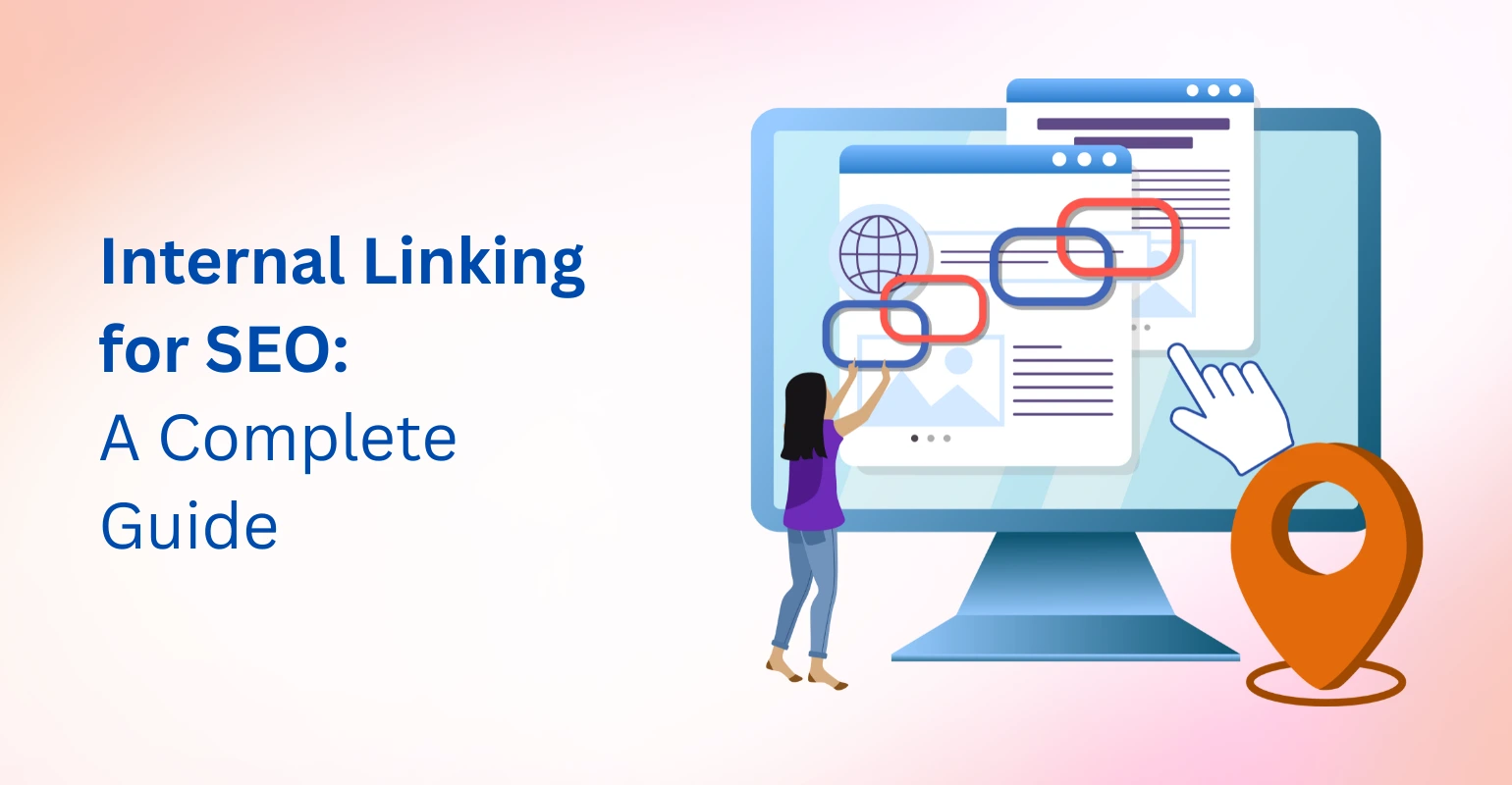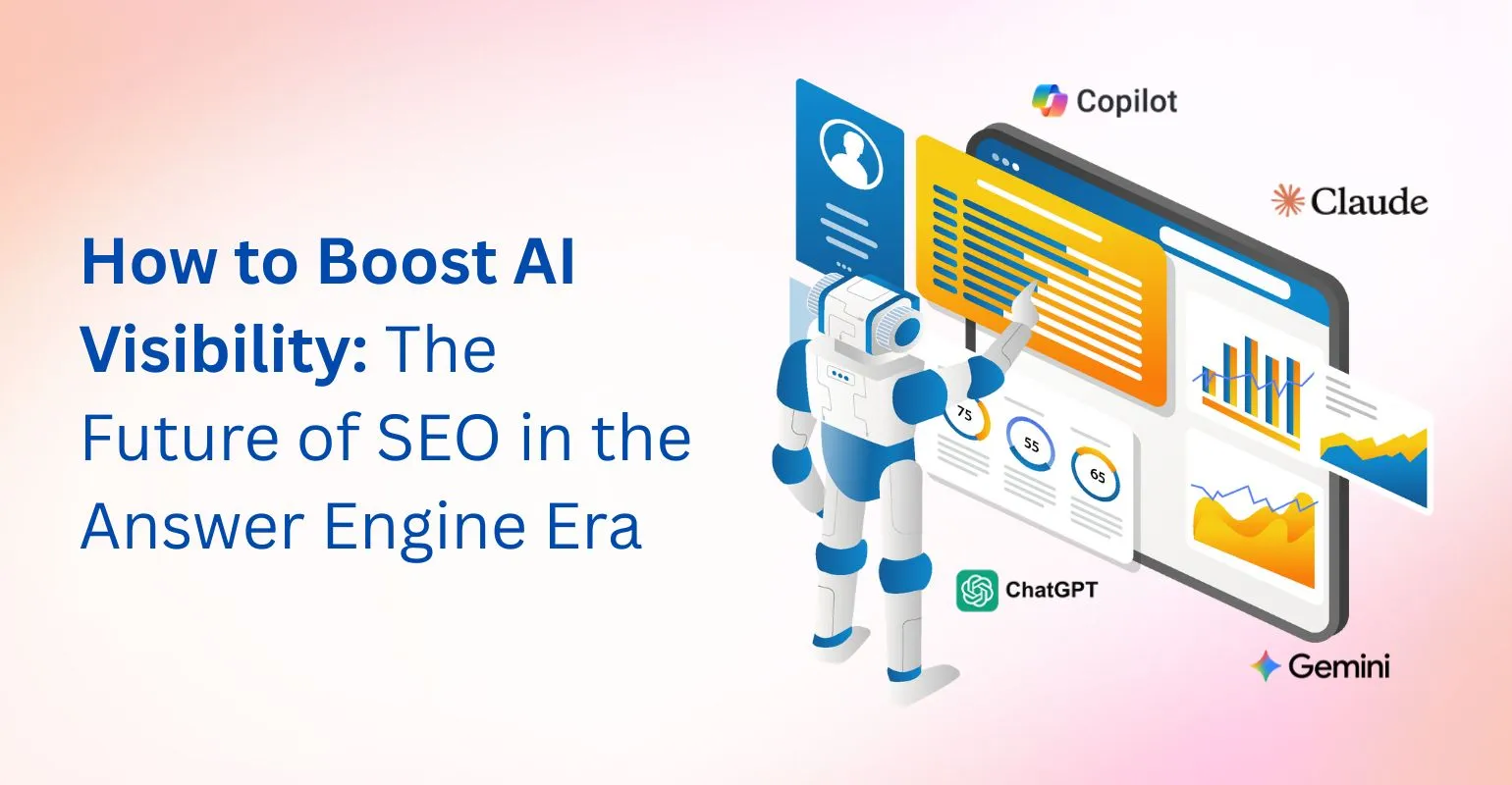blog
GEO vs Traditional SEO: Stop Guessing, Start Getting Found in 2025
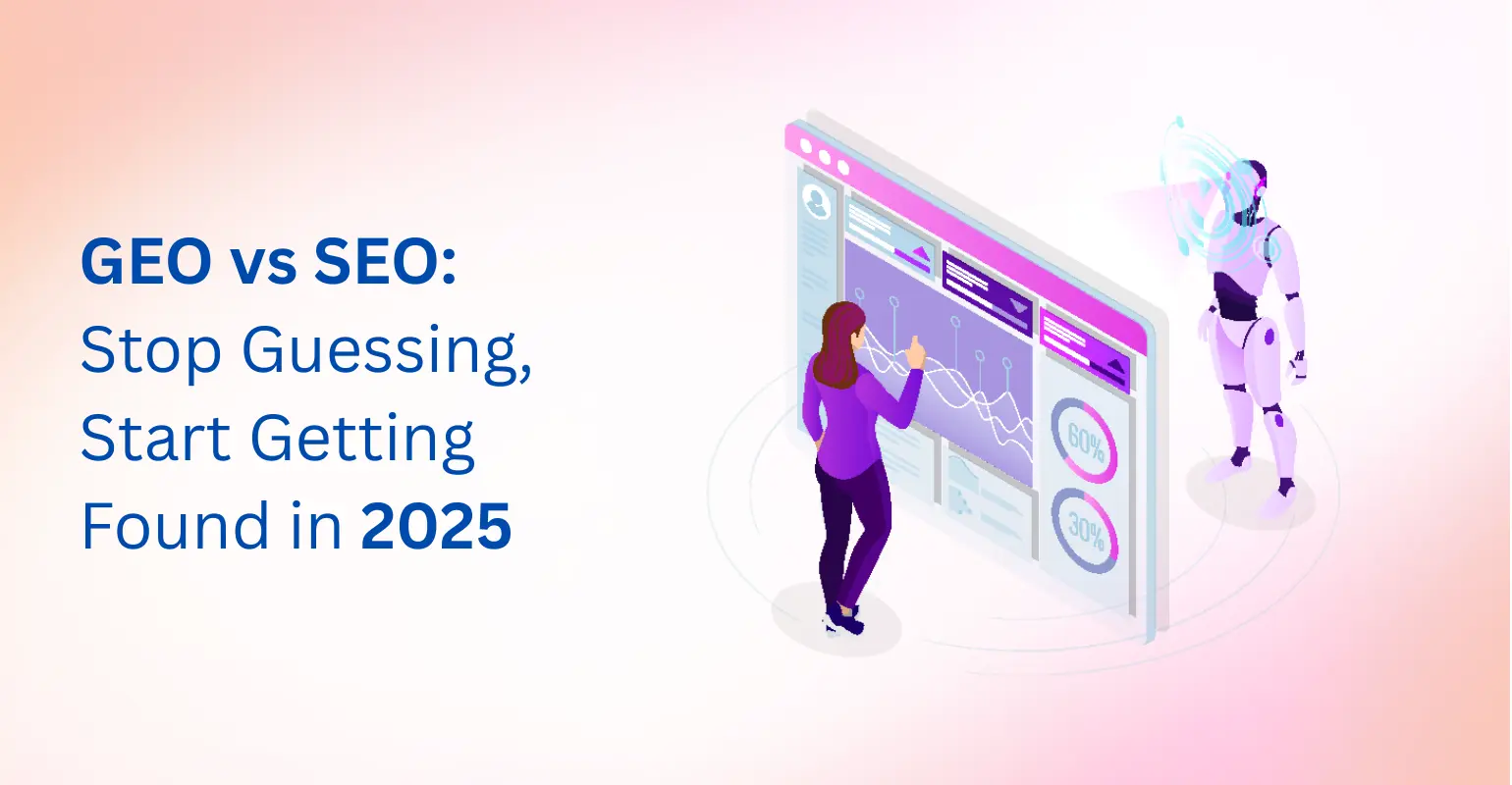
Search Has Changed. Has Your SEO Strategy?
If you’re still optimizing for blue links on Google… you’re already behind.
In 2025, users are asking questions directly to AI tools like ChatGPT, Bing Copilot, and Gemini and getting instant answers, no click required.
That means your content might be out of the conversation even if you’re #1 on Google.
Enter GEO (Generative Engine Optimization), a new way to optimize your content for AI-powered answers, not just search engine rankings.
While traditional SEO focuses on keywords, backlinks, and technical audits, GEO is about being cited, quoted, and referenced by AI engines in their responses.
It’s the difference between being found and being recommended.
In this post, you’ll learn:
The key difference between GEO and traditional SEO
Why ranking in AI responses matters more than ever
How forward-thinking agencies like Tangence are helping brands show up where it counts: inside AI engines
If you want to stay visible in an AI-dominated search landscape, keep reading. GEO isn’t just the future of SEO, it’s already here.
What Is Traditional SEO? (The Basics Recap)
Before we dive into GEO, let’s take a step back and revisit what traditional SEO actually involves.
Traditional SEO – the kind most marketers are familiar with, is the process of optimizing your website to rank higher in search engine results pages (SERPs), particularly on Google.
The goal?
Get found organically by users searching for keywords relevant to your business.
Here are the core components of traditional SEO:
Keyword Research
At the heart of every SEO campaign is keyword intent.
SEO experts identify terms users are searching for, whether informational (“what is X?”), navigational, or transactional and build content to target those terms.
On-Page Optimization
This includes optimizing:
- Meta titles and descriptions
- Heading structure (H1-H3)
- Keyword placement in content
- Image alt text
- Internal linking strategy
Technical SEO
This side focuses on how your site performs in the eyes of Googlebot:
- Fast page load speeds
- Mobile-first design
- Crawlability and indexing
- XML sitemaps and robots.txt configuration
- Canonical tags to prevent duplicate content issues
Off-Page SEO & Backlinks
Earning high-quality backlinks from other websites signals authority to Google.
The more reputable sites linking to you, the more likely you’ll climb the SERPs.
Content Creation
Content is the backbone of SEO.
Informational blog posts, landing pages, guides, FAQs, all play a role in educating searchers and improving visibility.
Traditional SEO: Strengths
- Proven ROI: SEO consistently delivers one of the highest returns in digital marketing.
- Evergreen Value: Well-optimized content can drive traffic for months or even years.
- Scalable: Once the foundation is set, SEO becomes a long-term growth channel.
- Google Ecosystem: 80%+ of web search still flows through Google, making traditional SEO a non-negotiable.
Traditional SEO: Limitations in 2025
However, the landscape is changing fast and traditional SEO has some blind spots:
- Zero-click searches are increasing, where users get their answers directly in the SERPs without clicking.
- AI assistants are bypassing search engines entirely.
- Your content might be invisible to LLMs (Large Language Models) if it’s only optimized for keywords, not for citation and structure.
That’s where GEO (Generative Engine Optimization) comes in.
What Is GEO (Generative Engine Optimization)?
GEO, or Generative Engine Optimization, is the next evolution of SEO, built for the era of AI-powered search.
Instead of optimizing content for search engines like Google, GEO focuses on making your brand discoverable and citable by generative engines such as:
- ChatGPT (OpenAI)
- Bing Copilot (Microsoft)
- Gemini (Google’s AI assistant)
- Perplexity AI, Claude, and other LLM-based interfaces
These platforms don’t show traditional search results.
Instead, they generate direct answers, pulling information from multiple sources in real-time or from the training data they’ve been exposed to.
So, if your content isn’t structured, relevant, and authoritative enough to be referenced by these AI engines, you’re not even in the conversation.
Understanding the mechanics of GEO vs Traditional SEO is key to choosing the right strategy for different types of content in 2025.
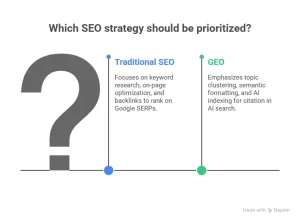
Image Source: Created using Napkin AI.
GEO Optimization: A New Playbook
Here’s how GEO differs from traditional SEO:
1. Citation over Ranking
GEO’s goal is not to rank #1 on Google, but to get quoted or cited inside an AI-generated answer.
If the LLM uses your content to inform its response (and ideally links to your site), you’ve won.
2. Structured, Schema-Enabled Content
AI engines favor structured data that’s easy to parse and reference.
Implementing FAQ schema, how-to markup, and clear formatting increases your chances of being picked up.
3. Conversational Relevance
Since generative engines mimic human conversation, your content should too. Content that’s clear, direct, and written in Q&A or dialogue-style performs better.
4. EEAT Signals Matter More
GEO emphasizes Experience, Expertise, Authoritativeness, and Trustworthiness, not just for Google, but for LLMs that are trained to value reputable sources.
5. Brand Mentions = Visibility
You don’t always need a link.
Being mentioned or summarized by an AI assistant can still drive awareness, trust, and indirect traffic.
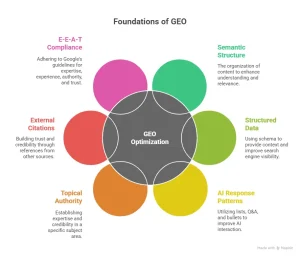
Image Source: Created using Napkin AI.
Why GEO Matters Now
At Tangence, we’ve been early adopters of GEO. We’re already helping clients:
- Structure their content for maximum AI discoverability
- Integrate GEO into traditional SEO roadmaps
- Track brand mentions in generative engines
- Future-proof their content for AI-driven search
Because here’s the truth: If AI is the new search engine, your brand must be AI-visible and not just Google-visible.
GEO vs Traditional SEO – Key Differences
In this section, we’ll break down the key differences between these two optimization strategies so you can understand how they complement, rather than compete with, each other in 2025.
Side-by-Side Comparison Table
| Aspect | Traditional SEO | Generative Engine Optimization (GEO) |
| Primary Goal | Rank on Google SERPs | Be cited by AI engines (e.g., ChatGPT, Copilot) |
| Search Interface | Search engines with links (Google, Bing) | Conversational AI tools (LLMs, chatbots, AI search) |
| Traffic Type | Click-based (organic traffic from SERPs) | Zero-click visibility (citations, summaries, AI mentions) |
| Optimization Focus | Keywords, backlinks, metadata, UX | Structured content, clarity, credibility, EEAT signals |
| Content Format | Long-form blogs, landing pages, SEO-optimized site structure | Clear Q&A, concise answers, schema markup, topical authority |
| Ranking Signals | Backlinks, on-page SEO, technical SEO | Source authority, clarity, usefulness, context relevance |
| Measurement | Impressions, organic clicks, rankings | Brand mentions in AI, referrals from AI search tools, zero-click impact |
| Tools Used | Google Search Console, SEMrush, Ahrefs | Perplexity, ChatGPT, Bing Copilot, AI auditing tools |
| Time to Results | Medium to long-term | Emerging rapid if content is AI-optimized |
| Main Risk | Algorithm updates (Google core updates) | LLM black-box behavior, unpredictable citation patterns |
What This Means for You
- Traditional SEO is still critical, it brings traffic from people using Google and Bing in classic ways.
- But GEO is your edge in the next wave of search, helping you appear where users are no longer seeing search results: inside the AI-generated answers.
GEO isn’t a replacement for SEO. It’s an evolution.
Together, they form a dual-engine strategy:
One engine feeds organic search.
The other gets you embedded in AI conversations.
Why GEO Matters More Than Ever in 2025
If 2023 was the year generative AI got everyone’s attention…
2025 is the year it rewrites how people find information.
GEO is redefining AI content optimization by ensuring your brand gets cited in AI-generated answers.
Today, millions of users ask questions directly to AI tools like ChatGPT, Gemini, Perplexity, and Claude, bypassing Google altogether.
These tools don’t show 10 blue links. They generate answers instantly, based on what they’ve learned or can reference in real-time.
That means your brand needs to be part of the answer, not just part of a SERP.
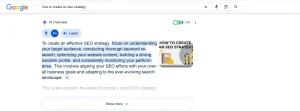
Image Source: Google Search – “AI Overview” (screenshot captured on 2025-08-11; query: “how to create an seo strategy)
The Decline of Clicks, Rise of Answers
Here’s what’s shifting right now:
- Over 60% of searches result in zero clicks (source: SEMrush, SparkToro)
- AI search tools like Perplexity and Copilot are training users to skip Google entirely
- Google’s own AI Overviews are reducing the need to visit websites
- AI-generated responses rarely include more than 3–5 sources and they’re not always links
If your content isn’t optimized for LLMs, it’s invisible where users are already spending time.
GEO Gives You a Competitive Edge
By embracing GEO now, you can:
- Own your niche inside AI-generated content
- Future-proof your visibility against declining search traffic
- Position your brand as a go-to source for AI tools when forming answers
GEO is like SEO in 2010, underutilized, misunderstood, and full of opportunity for early movers.
How to Optimize for GEO – A Practical Guide
By now, it’s clear: if you want your brand to be visible in AI-generated answers, you need to rethink how you optimize content.
Here’s your step-by-step GEO playbook designed to help your business get cited, mentioned, and trusted by generative engines like ChatGPT, Bing Copilot, Gemini, and Perplexity.
Step 1: Create Content That Answers Real Questions
LLMs thrive on clear, structured, and conversational content. That means:
- Use natural, question-based headings (e.g. “What is GEO?”, “How is GEO different from SEO?”)
- Provide direct, concise answers within the first few sentences
- Write like you’re speaking to the AI, not just a human reader
Pro tip:
Use tools like AlsoAsked or Google’s People Also Ask to identify question clusters your audience is actually typing.
Step 2: Format Your Content for Machine Readability
AI engines scan your content differently than Googlebot. Help them parse your material quickly by:
- Using clear HTML structure (H1-H3 hierarchy, short paragraphs, bullet points)
- Adding FAQ schema and How-To schema via structured data
- Embedding author information and publication dates for trust
Pro Tip:
We recommend using schema.org markup to tag FAQs and answers that you want AI engines to lift into answers.
Step 3: Build EEAT Into Every Page
AI models value credible, expert sources, especially those with Experience, Expertise, Authoritativeness, and Trust (EEAT).
To improve your EEAT score:
- Add author bios with credentials
- Cite reputable third-party sources
- Show evidence: charts, case studies, quotes
- Publish original research or insights
Step 4: Track and Audit Your AI Presence
Most businesses track search rankings. But GEO performance is harder to measure unless you know what to look for.
Start by:
- Asking ChatGPT and Perplexity direct questions and noting which sources they reference
- Using tools like ChatGPT Advanced Data Analysis, Perplexity Pro, or Google SGE to check how your brand appears
- Tracking brand mentions, not just backlinks
Step 5: Blend GEO With Traditional SEO
This isn’t an either/or. It’s a hybrid strategy.
Your blog post should:
- Rank in Google
- Be structured for LLM citation
- Answer user intent from both a human and AI perspective
At Tangence, we call this AI-inclusive content marketing and it’s the new standard for future-focused brands.
When to Use Traditional SEO vs GEO (Or Both!)
Not sure how to adapt your SEO for AI search? We recommend a hybrid model that balances evergreen SEO with GEO enhancements.
As the digital landscape evolves, smart marketers aren’t choosing between Traditional SEO and Generative Engine Optimization (GEO), they’re combining both for maximum visibility.
Each serves a unique purpose in your content strategy. Here’s how to know when to use one, the other, or both.
When to Use Traditional SEO
Traditional SEO remains your best bet when you need to:
- Dominate local seo
- Drive traffic to product or service landing pages
- Publish evergreen blog content that ranks over time
- Track consistent keyword performance through Google Search Console or SEMrush
In short: if you’re optimizing for Google’s SERP, traditional SEO is still your foundation.
When to Focus on GEO
GEO steps in when your goal is to show up inside AI-generated answers, especially in zero-click environments. Use GEO when you want to:
- Increase brand awareness in tools like ChatGPT, Gemini, Perplexity, and Bing Copilot
- Get informational content cited by AI engines
- Build trust and credibility as an authoritative source in your niche
- Influence how AI interprets and repeats your brand’s expertise
In 2025, users trust AI summaries and GEO helps make sure you’re part of that summary.
Best Practice: Use Both Strategically
Think of SEO and GEO not as competitors, but as two engines driving visibility.
- Use Traditional SEO to win rankings and traffic.
- Use GEO to win relevance and recognition in AI-powered answers.
Tangence specializes in building this dual-path strategy helping brands thrive in both traditional search and AI ecosystems with a unified, future-forward approach.
GEO vs Traditional SEO Isn’t a Choice – It’s a Strategy
In 2025, the brands winning online aren’t just ranking on Google. They’re showing up in AI-generated answers, being cited as trusted sources, and building authority beyond the SERPs.
That’s the power of GEO.
But this doesn’t mean SEO is dead. Far from it.
It means the rules of the game are evolving and those who adapt fastest gain the edge.
To stay visible, credible, and competitive, you need to combine:
- Traditional SEO (for rankings, traffic, conversions)
- GEO (for citations, brand awareness, and AI visibility)
Stay ahead of AI and search with a strategy designed around GEO vs Traditional SEO and the smart ways to blend them.
Don’t get left out of AI-generated answers.
Start your GEO strategy with Tangence today.
Frequently Asked Questions
1. What is Generative Engine Optimization (GEO)?
Generative Engine Optimization (GEO) is the process of optimizing your content so it can be discovered, cited, or referenced by generative AI tools like ChatGPT, Gemini, Perplexity, and Bing Copilot. Instead of optimizing for search engine rankings, GEO focuses on visibility inside AI-generated responses.
2. How is GEO different from traditional SEO?
GEO focuses on getting your content cited by AI, while traditional SEO is about ranking in Google’s search results.
- Traditional SEO = Click-throughs from SERPs
- GEO = Being part of the answer users see in AI platforms
Smart marketers use both for maximum visibility.
3. Is GEO replacing traditional SEO in 2025?
No but it’s quickly becoming equally important. As users rely more on AI tools for answers, GEO is how your brand gets discovered in zero-click, AI-generated environments. Traditional SEO is still critical for ranking on Google, especially for local and transactional queries.
4. How do I optimize my content for GEO?
Start by:
- Answering common questions clearly and concisely
- Using structured content (headings, bullet points, schema)
- Building EEAT signals (expertise, trust, author credibility)
- Auditing how your brand appears in tools like ChatGPT or Perplexity
Want help? Tangence can build your dual-path strategy (GEO + SEO) from the ground up.
5. Can GEO help improve brand awareness?
Absolutely. When your content is consistently referenced in AI-generated answers, users begin to recognize your brand as a trusted expert, even without clicking a link. This is next-gen content visibility without relying on rankings or ads.
6. Do generative engines like ChatGPT credit sources?
Some do, some don’t. Tools like Perplexity and Bing Copilot often include citations or clickable links. Others, like ChatGPT, may reference your content without linking, making it even more important to structure your content for AI recognition.


